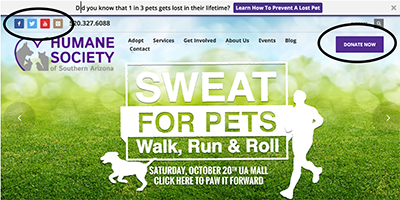5 Tips to Enhance Your Digital Fundraising Strategy

Nothing beats face-to-face interactions, but digital fundraising is a great tool to attract new donors! With the option for telling stories online and tracking your digital efforts, social media and emails are becoming more widely used to reach those donors who are engaging with online platforms. Check out the five tips below on how to master your digital fundraising strategy and take your organization to the next level.
Use a CRM system
You likely have many donors to keep track of, and a CRM can help you do that. “CRM” stands for Customer Relationship Management, which is a software or program that allows you to better manage the relationships your organization has with others. Using a program like this can help you create personal, lifelong relationships by maintaining prospect information, like biographical details, actions, interests, giving history, and more. It’s also an easy way to track communication history with your donors, including phone calls, emails, meetings, and event attendance. Knowing these details can help you keep track of how your organization is connecting with people and help you better understand your donors.
So, which CRM should you use?
There are many different CRM platforms available, and ultimately, you’ll need to do your research, pull quotes, and attend demos to fully understand these platforms and identify which one works best for your team. But here are some options available:
- Salesforce
- DonorPerfect
- Raiser’s Edge
- Neon
- Salsa
- HubSpot
Make the most of peer-to-peer and event donations
First, let’s define the term “peer-to-peer fundraising.” What is it, exactly?
Peer-to-peer fundraising is an effort that encourages people to reach out to one another on behalf of a cause. When a donor invites their family members or friends to support a cause, they are exercising peer-to-peer fundraising. This type of fundraising is commonly known as “social fundraising,” and is most often seen with social media platforms, runs, events, and more. This is a unique tool to use for fundraising efforts, simply because your organization is inviting the community to tell stories, share your cause, and take a personal interest in garnering support for your organization.
There are several platforms that can help you make the most of your peer-to-peer and event fundraising strategies by providing event ticketing and registration, peer-to-peer campaigns, analytics reports, social media integration, and more. A few of these platforms include:
- Classy
- Network for Good
- Double the Donation
- One Cause
Make your website work for you
There isn’t one foolproof way to design your website, as long as it’s clean and easy to navigate. However, there are several key things you need to remember when designing your website:
Make it mobile-friendly
51% of people who visit a nonprofit’s website do so on a mobile device, so make sure your website can take on that traffic and present the details in an easy-to-follow format.
Have an easy-to-find place for donations
Your website’s job is to explain your cause, attract donors, and provide an easy place to make donations. So, add a “donation” button at the top of your site to make it easy on your donors. Once donors click on the button, consider adding suggested donation amounts to help your donors.
Add your social media platforms
Social media is another easy way for donors and the community to engage with your organization, so be sure your platforms are easy to identify on your website and link directly to your pages. Check out the photo below to see an example of easy-to-locate social media widgets and a donation button.
Be consistent throughout
Your site needs to be consistent with components like font type, size, header designs, etc. If your site looks different from page to page, you are more likely to lose your audience. Clarity and simplicity go a long way, so don’t make your site overly complicated or “busy.”
State your mission
This might be the most important component of website design! State your mission somewhere obvious, and make sure it’s present throughout your site with stories that explain how your organization supports your cause.
Use data to your advantage
Review your website consistently and pull analytics reports to help you identify which pages are working for your organization and which pages could use some improvement.
Enhance your email marketing strategy
Email marketing is a great way to consistently stay in touch with your donor base, report on news from your organization, and share stories from your community. Many people don’t donate the first time they visit your site, so following up by email is a great way to build the relationship over time. You can also use emails to build loyalty with past donors.
Email Do’s
- DO let donors know how they helped
- DO tell your organization’s story
- DO segment your audience for best results; this allows you to send out targeted emails, rather than blanket messages that apply to everyone
- DO personalize your messages
Email Don’ts
- DON’T send emails too often, or you may lose subscribers
- DON’T make your emails too busy. Keep them clean and simple
- DON’T overload your audience with too much information
There are also a variety of email marketing programs to help your organization keep track of your contact lists, send emails, and view analytics about your communications. Here are some examples:
- MailChimp
- HubSpot
- Constant Contact
- Vertical Response
- Emma
Step up your social media game
Social media is important for connecting with your audience, identifying trends, and reaching new donors. But social media is more than just sharing photos and event information, so check out these tips to enhance your social media presence.
First, you need to develop your social media strategy with this 5-step process:
- Determine your goals/purpose: Use the S.M.A.R.T. goal method.
- Define your target audience: Be specific! The “general public” is too broad.
- Develop your voice: Do you want your organization to be perceived as knowledgeable? Fun? Innovative?
- Create a content strategy: Not sure what to post? Check out the HubSpot marketing blog for content ideas.
- Define success metrics: Identify how you will measure the success of your social media platforms with analytics such as website clicks, impressions, page likes, etc.
Second, choose which platforms work best for you.
There are a variety of reasons why you may choose to participate in one platform over another, but it all comes down to one question: where is your audience? Once you answer that question, you can choose which platforms work best for your organization, such as Facebook, Instagram, LinkedIn, Twitter, and more.
Third, take advantage of paid and organic social media strategies.
Organic posts are for establishing your organization as a thought leader in the nonprofit space and keeping your organization relevant. Paid ads are great for targeting specific demographics based on interests, education levels, geographical location, and more. A successful social media strategy often relies on both components, so consider adding these to your digital fundraising strategy.
Looking for more information on how to improve your digital fundraising tactics? Register for our virtual panel, Making the Most of Your Digital Fundraising Strategy!

